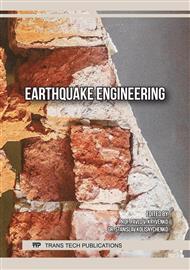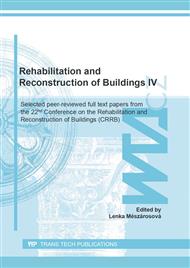[1]
N. Augenti, F. Parisi F., Learning from Construction Failures due to the 2009 L'Aquila, Italy, Earthquake. Journal of Performance of Constructed Facilities. ASCE, 24 6 (2010) 536-555.
DOI: 10.1061/(asce)cf.1943-5509.0000122
Google Scholar
[2]
S.A. Babatunde, Review of strengthening techniques for masonry using fiber reinforced polymers. Composite Structures, 161 (2017) 246–255.
DOI: 10.1016/j.compstruct.2016.10.132
Google Scholar
[3]
M. Corradi, A. Borri, A. Vignoli, Experimental evaluation of the in-plane shear behaviour of masonry walls retrofitted using conventional and innovative methods. J Br Mason Soc, 21-1 (2008) 29–42.
Google Scholar
[4]
T.C. Triantafillou, Textile-Reinforced Mortars (TRM) - A new generation of composite materials as alternative to fiber reinforced polymers for strengthening and seismic retrofitting of structures. Composite Materials - A Vision for the Future (2011) 113-127.
DOI: 10.1007/978-0-85729-166-0_5
Google Scholar
[5]
D. Arboleda, S. Babaeidarabad, C.D. Hays, A. Nanni, Durability of Fabric Reinforced Cementitious Matrix (FRCM) composites. In: Proceedings of the 7th International Conference on FRP Composites in Civil Engineering, CICE 2014, Vancouver (CA).
Google Scholar
[6]
J. Donnini, F. De Caso y Basalo, V. Corinaldesi, G. Lancioni, A. Nanni, A. Fabric-reinforced cementitious matrix behavior at high-temperature: Experimental and numerical results. Composites Part B, 108 (2017) 108–121.
DOI: 10.1016/j.compositesb.2016.10.004
Google Scholar
[7]
F. Micelli, M. Corradi, M. Aiello, A. Borri, Properties of Aged GFRP Reinforcement Grids Related to Fatigue Life and Alkaline Environment. Applied Sciences, 7 (2017) 897.
DOI: 10.3390/app7090897
Google Scholar
[8]
N. Ismail, J.M. Ingham, In-plane and out-of-plane testing of unreinforced masonry walls strengthened using polymer textile reinforced mortar. Engineering Structures, 118 (2016) 167–177.
DOI: 10.1016/j.engstruct.2016.03.041
Google Scholar
[9]
C.G. Papanicolaou, T.C. Triantafillou, M. Papathanasiou, K. KarloS, Textile reinforced mortar (TRM) versus FRP as strengthening material of URM walls: out-of-plane cyclic loading. Materials And Structures, 41 (2008) 153-157.
DOI: 10.1617/s11527-007-9226-0
Google Scholar
[10]
N. Gattesco, I. Boem, Experimental and analytical study to evaluate the effectiveness of an in-plane reinforcement for masonry walls using GFRP meshes, Construction and Building Materials, 30 88 (2015) 94-104.
DOI: 10.1016/j.conbuildmat.2015.04.014
Google Scholar
[11]
N. Gattesco, I. Boem, Out-of-plane behavior of reinforced masonry walls: Experimental and numerical study, Composites Part B, 128 (2017) 39-52.
DOI: 10.1016/j.compositesb.2017.07.006
Google Scholar
[12]
F.G. Carozzi, A. Bellini, T. D'Antino, et al., Experimental investigation of tensile and bond properties of Carbon-FRCM composites for strengthening masonry elements, Composites Part B, 128 (2017) 100–119.
DOI: 10.1016/j.compositesb.2017.06.018
Google Scholar
[13]
M. Leone, M.A. Aiello, A. Balsamo, et al., Glass fabric reinforced cementitious matrix: Tensile properties and bond performance on masonry substrate, Composites Part B, 127 (2017) 196–214.
DOI: 10.1016/j.compositesb.2017.06.028
Google Scholar
[14]
N. Gattesco, I. Boem, Characterization tests of GFRM coating as a strengthening technique for masonry buildings, Composite Structures, 165 (2017) 209-222.
DOI: 10.1016/j.compstruct.2017.01.043
Google Scholar
[15]
V. Turnsek, A. Cacovic, Some experimental results on the strength of brick masonry walls. In: Proceedings of the 2nd Int. Brick Masonry Conference (1971) 149-156, Stoke on Trent (UK).
Google Scholar
[16]
TNO Building and Construction Research, DIANA finite element analysis user's manual. Release10.2. September (2017).
Google Scholar
[17]
CSLP - Consiglio Superiore dei Lavori Pubblici, Circolare del Ministero delle infrastrutture e dei trasporti 21 gennaio 2019, n. 7 Istruzioni per l'applicazione dell'«Aggiornamento delle "Norme tecniche per le costruzioni"» di cui al Decreto Ministeriale 17 gennaio 2018,. Rome, I: CSLP.
DOI: 10.3280/ed2014-001008
Google Scholar



